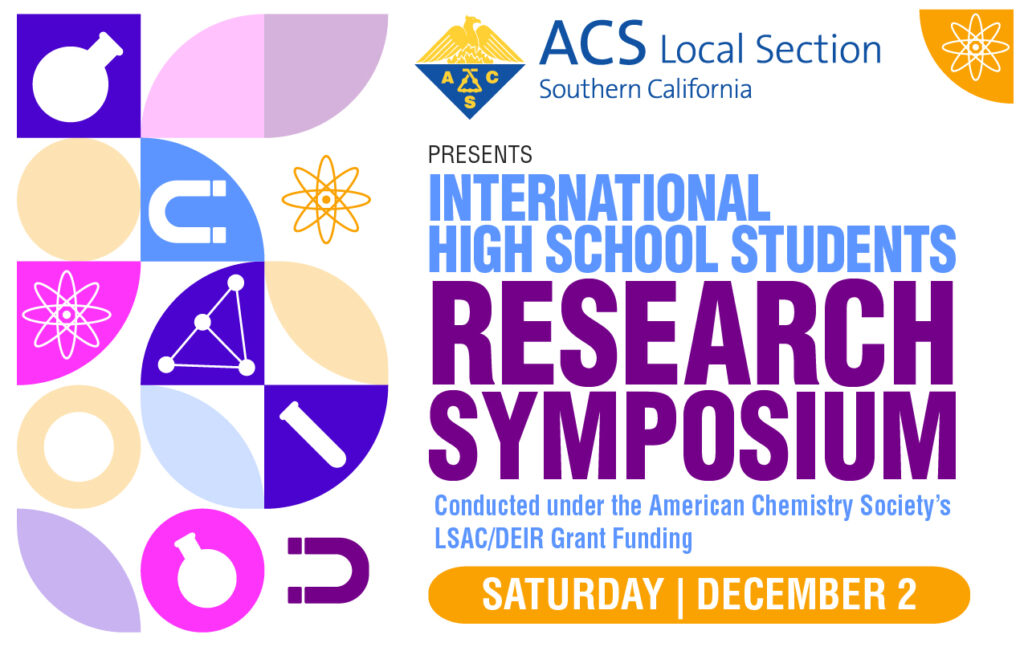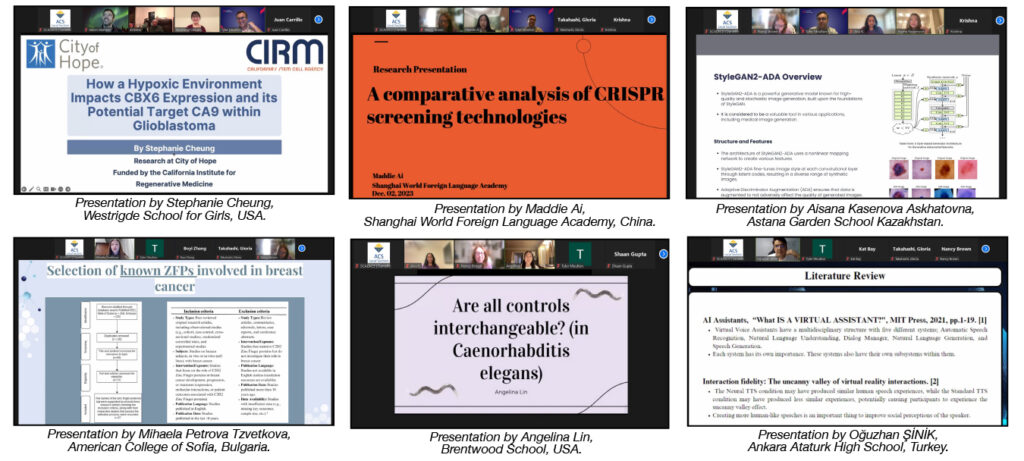This virtual event was hosted under the ACS’s LSAC/DEIR Grant Funding featuring 15-minute PowerPoint presentations from high school students all over the world on their research related to STEM subjects, conducted in 2 sessions, morning and afternoon.
This symposium for high school students to present their research is the first of its kind organized by SCALACS since its inception. It is perhaps the first of its kind in the country itself. Lumiere Education, an organization that promotes high school students’ research, is the sponsor of this event and contributed 21 of its students out of a total of 28 presenters. Lumiere was founded by Harvard graduates and caters to students all over the world. Among the participating students, eight are from California and belong to the area under SCALACS jurisdiction. Seven are from the USA, namely the states of New York, New Jersey, Georgia, Virginia, and Maryland. Five are from India and one each from Bulgaria, China, Egypt, Ireland, Kazakhstan, Mexico, and Pakistan. All presentations were done in English.
The topics of research presented included widely differing areas. Some focused on the applications of artificial intelligence and machine learning in climate studies, traffic control, automotive design, racial biases, health care, quantum particle studies, and privacy considerations of Twitter content and its ethical impact on women. Other presentations dealt with biological or medicinal chemistry involving studies on DNA/RNA, proteins, and other biomolecules concerning the detection and treatment of ailments such as cancer, disorders of the brain, and other organs, stroke, and transplants.
Eight judges participated in evaluating the presentations for awarding gift certificates to the top six students and included Nancy Brown of California Academy of Math and Science (CAMS), Carson; Katherine Bay, Boyi Zhang, and Emma Kuczkowski of Schrodinger Technologies, New York; Anu Kallury of Stripe Financial; and two SCALACS Executive Committee members, Veronica Jaramillo and Aaron Moment. Our sincere thanks to all of them for taking the time to judge the event.
We also thank Tyler Moulton, Head of Academic Programming of Lumiere, for functioning as event coordinator, and Krishna Kallury, SCALACS Councilor, for putting this event together.
| PARTICIPANTS | HIGH SCHOOL | TITLE OF PRESENTATION |
| Maddie – Yuhan Ai | Shanghai World Foreign Language Academy | A Comparative Analysis of CRISPR Screening Technologies. |
| Ayaan Waqar | Aitchison College | What are the privacy considerations in federated machine learning for healthcare wearables? |
| Aashima Keswani | The International School Bangalore | Data Privacy and User Awareness of Teenagers, in India, on Instagram in Relation to Ethical Impact on Women. |
| Ryan Santosh | Oberoi International School | Employing Machine Learning Techniques and Frameworks to Aid with Automotive Design. |
| Adhiraj Gupta | Sishya School | How do different CNN architectures compare for the task of classifying road signs and drawing bounding boxes around them? |
| Kedar Matheikal Manoj | Stonehill International School | To what extent does the CMB show us the different concentrations of matter in the universe and the shape and rate at which the universe has expanded? |
| Mihaela Petrova Tzvetkova | American College of Sofia | What is the impact of zinc finger proteins in developing and promoting metastasis in breast cancer? |
| Oguzhan Sinik | Ankara Ataturk High School | What are the key characteristics of human speech that contribute to perceived naturalness? What are the technical challenges in creating human-like sounds for virtual voice assistants, and how can these challenges be overcome? |
| Nada Elmahmoudy Hassan Elazazy Harraz | Dakahlia STEM High School | How can rising sea levels affect The Coastal zone of the Nile Delta in Egypt? |
| Udaiveer Parihar | The Institute of Education | Evaluating the effectiveness of a PMSA (Prostate Membrane Specific Antigen) antigen radioisotope-based screening method in screening for PDAC (Pancreatic Ductal Adenocarcinoma) in high-risk populations compared to existing screening tools. |
| Aisana Kasenova Askhatovna | Astana Garden School | How are racial biases within the training datasets used to develop AI models affect the accuracy and reliability of dermatological diagnoses? |
| Kaylyn Sethakosee | Thomas Jefferson High School for Science and Technology, VA | Did the COVID-19 pandemic have an adverse effect on pregnancy outcomes and C-section rates in the state of Massachusetts? |
| Raiya Minhas | Parkdale Collegiate Institute | Investigating the effect of integrated medical technologies on the instances of heart transplants through a statistical data analysis. |
| Yung Hau Hong Joseph | Georgetown Preparatory School | How did different Covid-19 policies impact stroke admissions and the severity of stroke in Hong Kong? |
| Simar Rajpal | JP Stevens High School Edison NJ 08820 | Comparing protein structure prediction using AlphaFold to protein structures that were solved experimentally for key oncogenic proteins involved in cancer progression. |
| Vivian Nguyen | North Gwinnett High School | How do we compute a time-evolution equation for a single-particle Green’s function in order to describe the dynamic behavior of a single quantum particle in a system? |
| Anant Gupta | John P. Stevens High School | To what extent can large language models help to predict changes in the stock market? |
| Kanjonavo Sabud | Thomas Jefferson High School for Science and Technology | Projected Escalation of Wildfire Severity Due to Climate Change in Maryland USA: A Machine Learning and Climate Simulation Approach. |
| Bhavika Bhasin | Jericho Senior High School | ABSS – A novel screening exam for Autism Spectrum Disorder in adults. |
| Jose Maria Salvador | Prepa Tec CSC | Are attention-based neural networks more effective than any other neural network architecture for software vulnerability analysis? |
| Niharika Sapre | Mountain House High School, CA | How can computational methods help increase the efficiency of small farmers’ harvest and make work less arduous? |
| Andrea Quinones | Francisco Bravo Medical Magnet High School, CA | The effects of Acetaminophen and Genistein on Sperm Production. |
| Julia Bustos | Francisco Bravo Medical Magnet High School, CA | Developing an Immunotherapy for Small Cell Lung Cancer Using a Naturally Occurring Autoimmune Response. |
| Juan Carrillo | Francisco Bravo Medical Magnet High School, CA | Evaluating the molecular mechanism of genesis of cancer stem cells induced by Hepatitis C virus and/or environmental factors (alcohol or obesity). |
| Stephanie Cheung | Westrigde School for Girls, CA | How a Hypoxic Environment Impacts CBX6 Expression and its Potential Target CA9 within Glioblastoma. |
| Ruby Yoon | Francisco Bravo Medical Magnet High School, CA | Implications of Morphometric Variation in the Human Fifth Metatarsal for Restoring Functionality After Fracture. |
| Leon Chen & Shaan Gupta | La Canada High School, CA | Field study of carbon dioxide concentration variability in Los Angeles County over a decade. |
| Angelina Lin | Brentwood School, CA | Are all controls interchangeable? (in Caenorhabditis elegans) |
The following students were adjudged to be the top six presenters and were given Gift Certificates of one hundred dollars each. The funds were provided by a Local Section Activities Committee (LSAC/DEIR) grant.
• Stephanie Cheung
• Ryan Santosh
• Adhiraj Gupta
• Nada Elmahmoudy Hassan Elazazy Harraz
• Angelina Lin
• Mihaela Petrova Tzvetkova
Our congratulations to all of the top presenters and our appreciation to all the presenters for their wonderful and exciting presentations! SCALACS hopes to continue organizing similar symposia next year.



